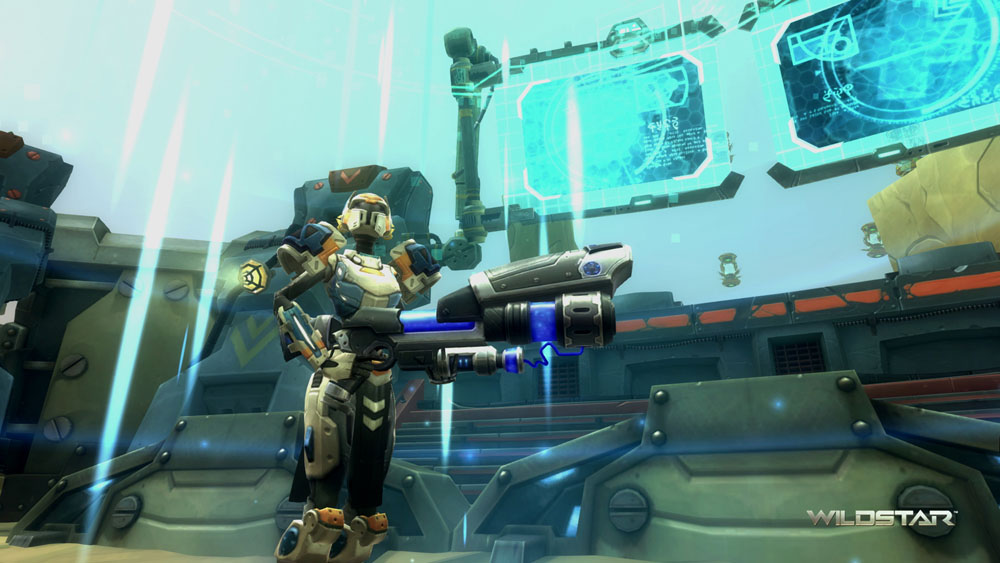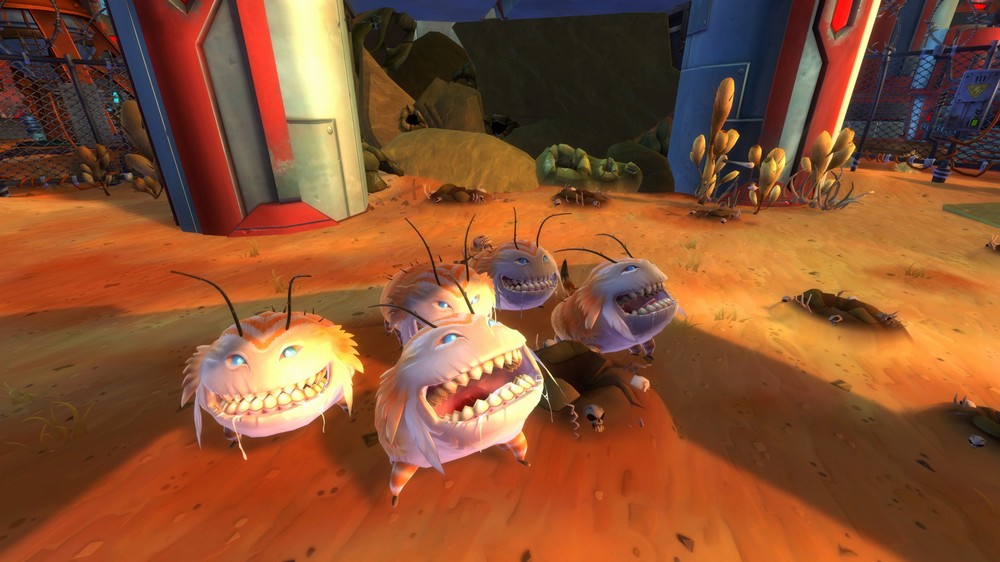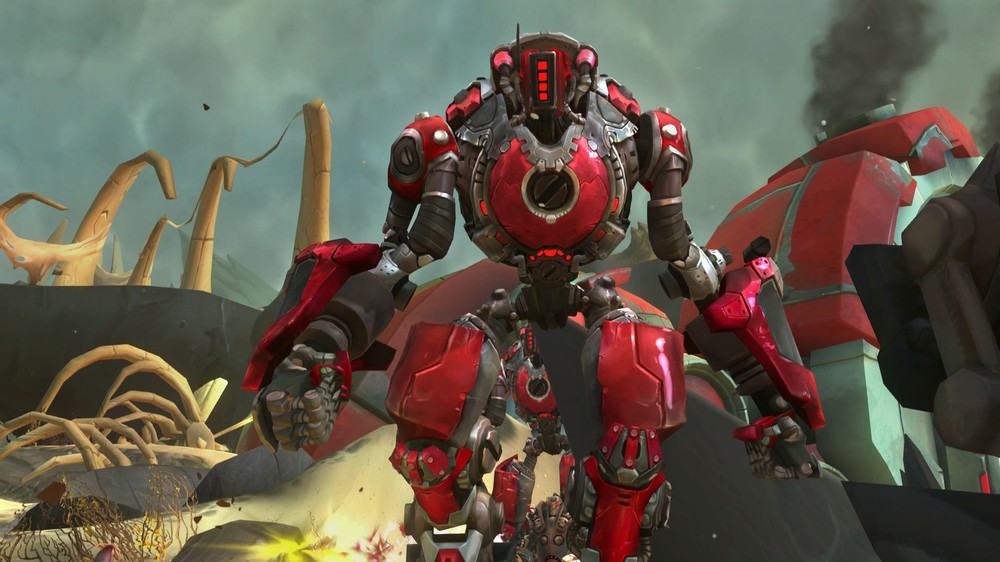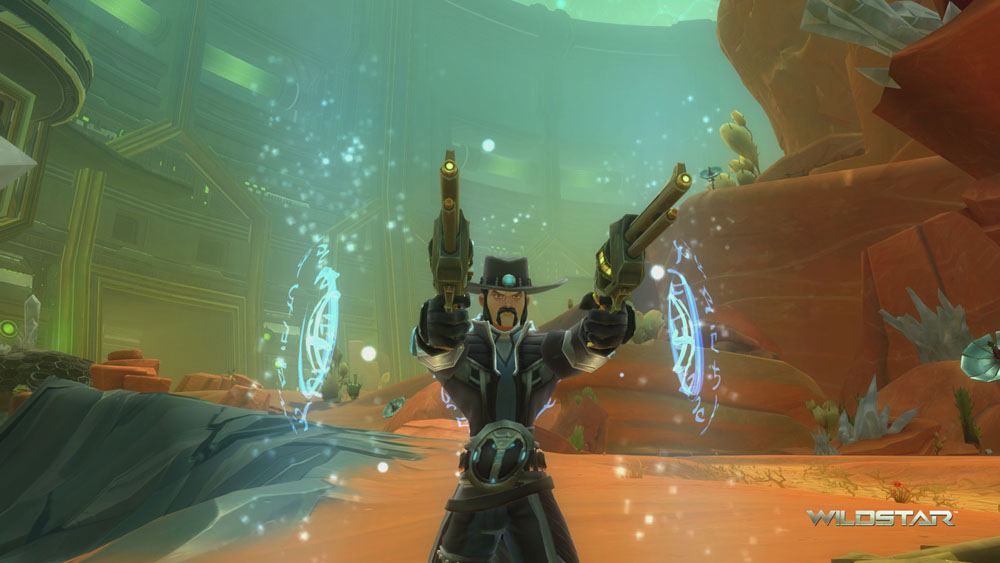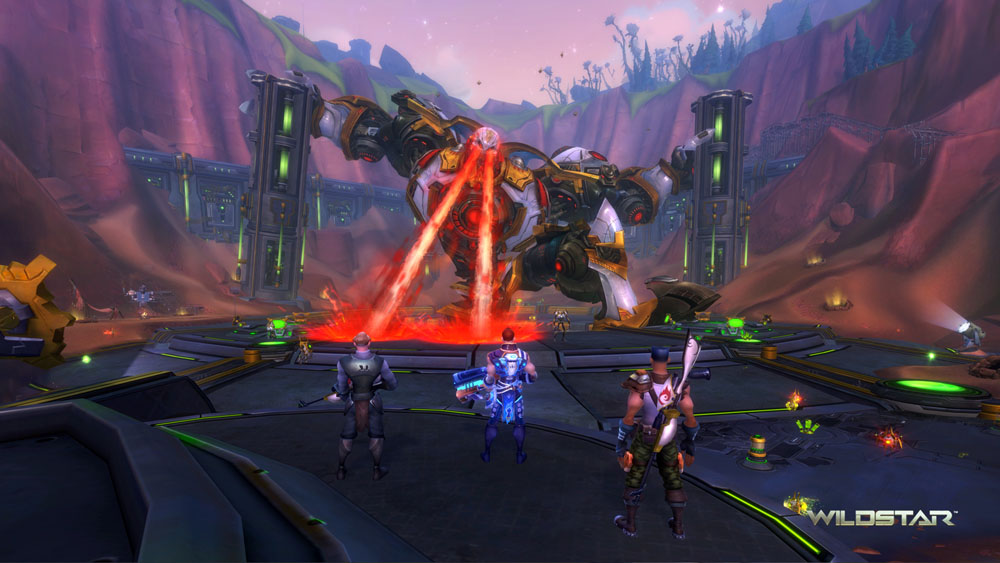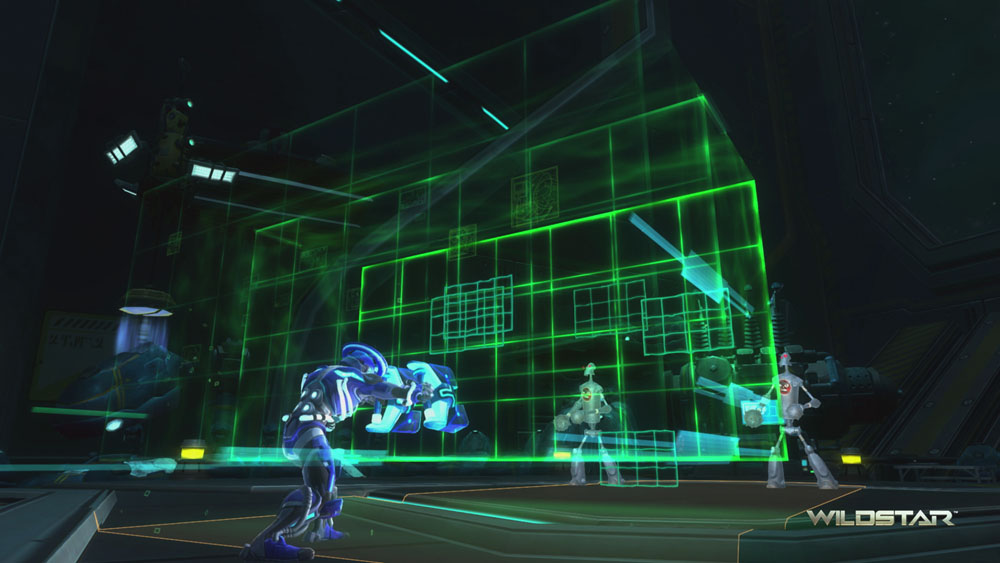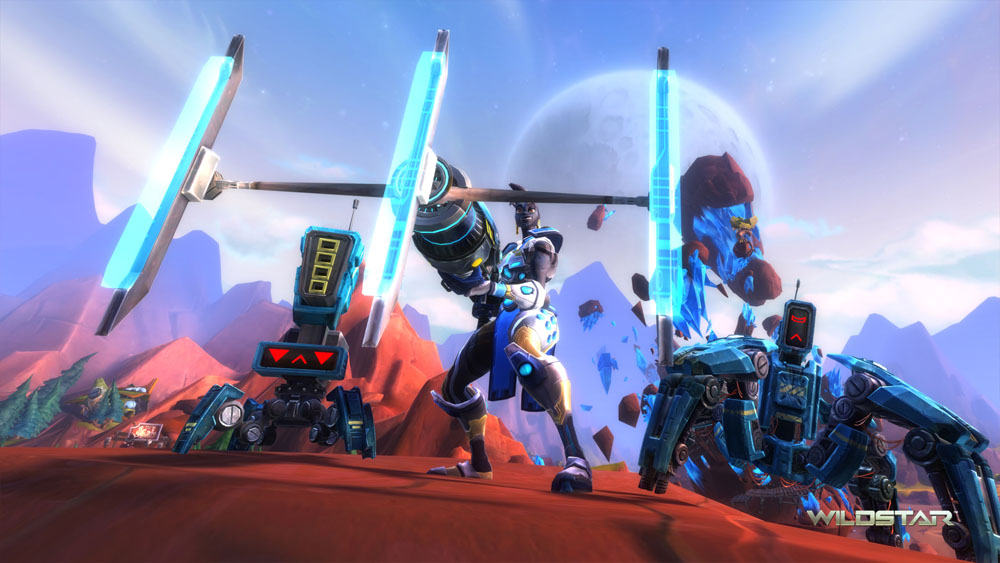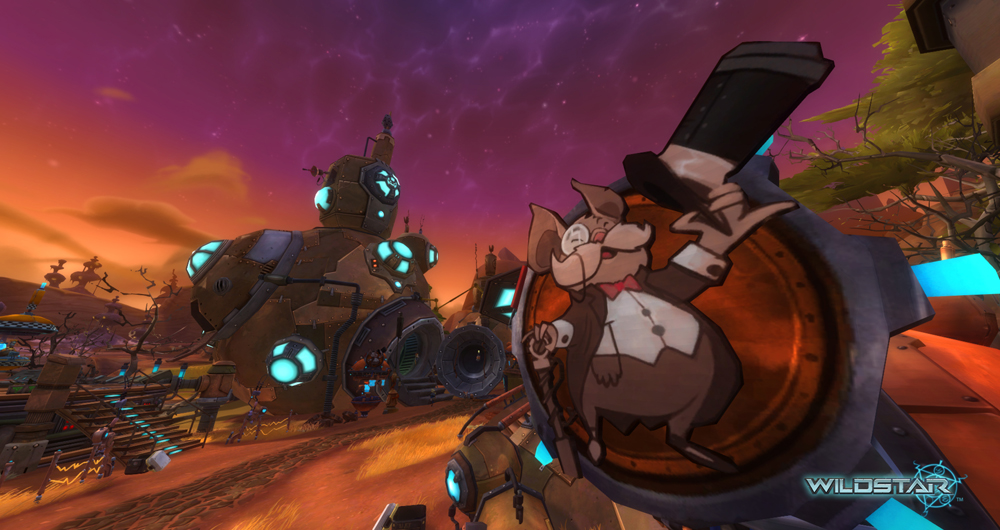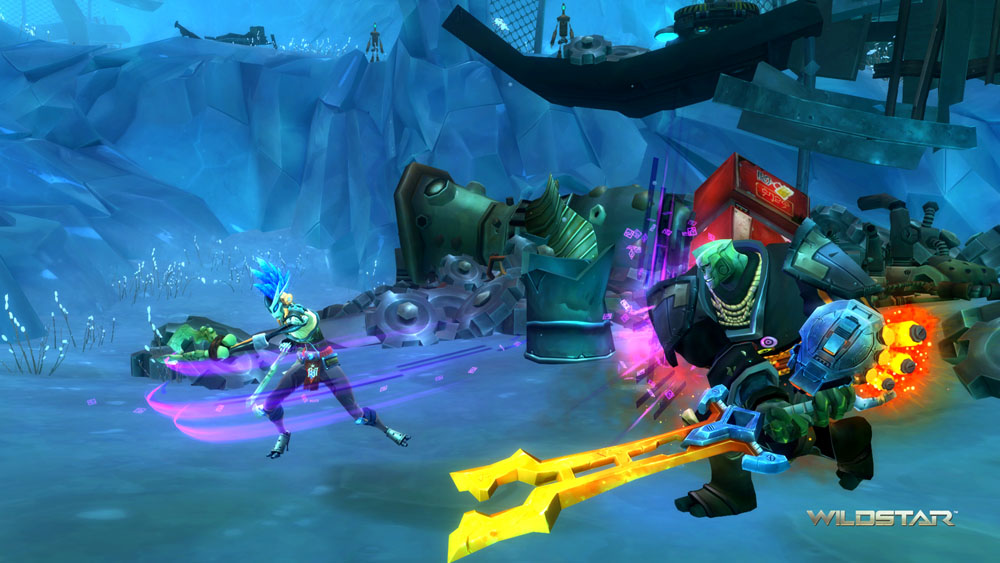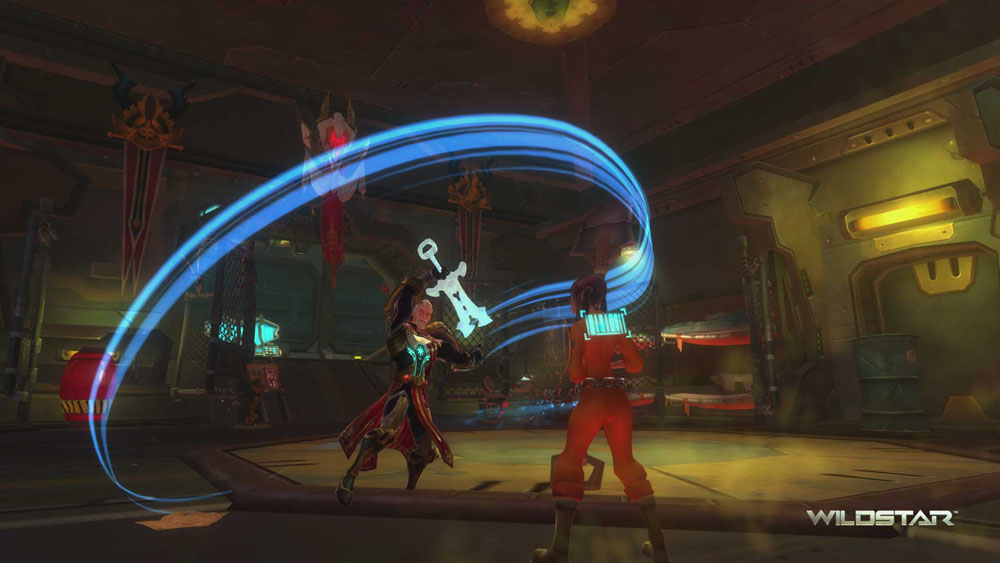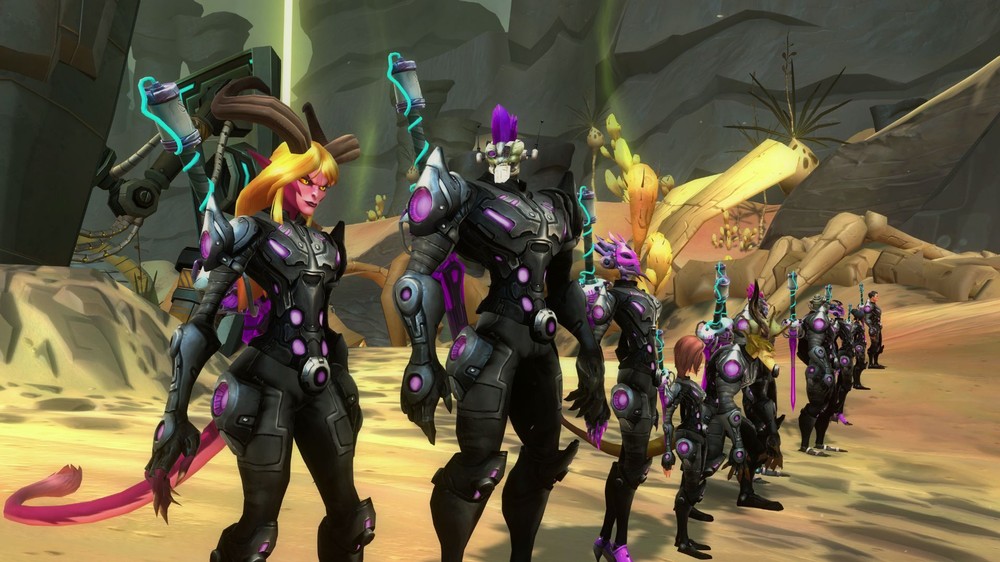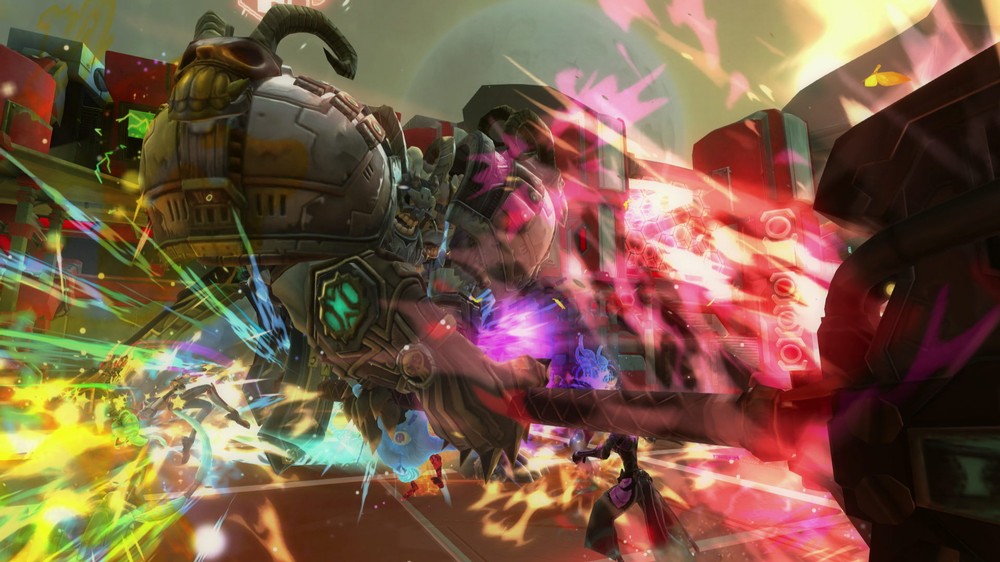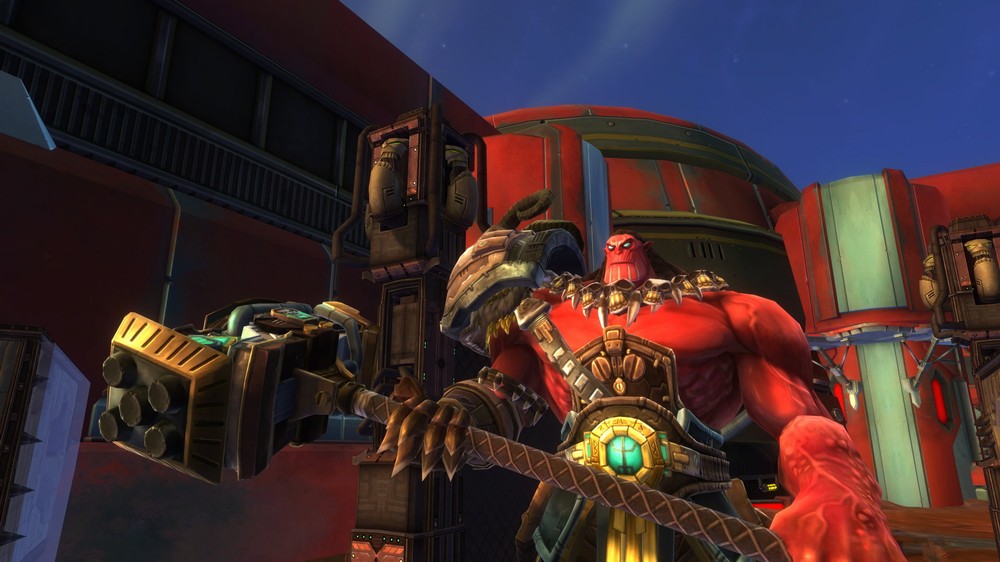WildStar’s a bold move to make in 2014. We’re in the golden age of free-to-play (which is to say, some of the games are worth playing for reasons other than ‘free’), so it takes a certain amount of boldness on the part of Carbine to make a brand-new game and actually charge to play it. But, aside from being plagued by the tech issues common to new MMOs, WildStar manages to back it up. Its distinct style, unique group content, and engaging story make it a game that’s worth playing.
For the purposes of my part of this review, I played a human exile medic to level 50, spec’d as a healer when I grouped up and, of course, focused on damage when I was alone. The medic’s WildStar’s damage over time class, or at least it can be. When I fought, I specialized in dropping fields of damage on the ground, overlapping them for maximum pain. It was a pretty fun way to fight, though it was always a downer to see a more burst-capable class explode an enemy I was fighting and take most of the kill credit.
That said, leveling in WildStar is pretty painless. Compared to other MMORPGs, the XP curve is fairly flat, and the time to level from 19 to 20 isn’t too much less than the time to level from 49 to 50. Once you get your house, rest XP is fairly generous, and I was able to hit the level cap after about a week and a half of dedicated play, which was some of my best time with the game.
I was drawn in by the game’s lore especially, the history of Nexus, full of species living in the shadow of the long-departed Eldan, and the off-world visitors looking to reap the world’s bounties. Both were fascinating, and the sheer amount of information presented – largely unobtrusive, so it’s there for the lore nerd, but not in the way of anyone who doesn’t bother reading quest text – dazzled me as a fan of the world. Each zone was full of new information, and the exploration was made all the better by the variety within each zone. Each zone had multiple biomes, enhancing the feel of exploration and making me excited to see what was over the next hill in a way I haven’t been in most games.
That said, there are some areas that kind of drag. I ended up skipping most of the non-story quests in the end of Whitevale and the start of Farside, when it just seemed like too much effort to grind out what the quest needed. But that was a just a small nadir in what was, overall, a very enjoyable experience. It certainly doesn’t hurt that the combat’s very engaging, built around interrupting enemy casts, dodging telegraphed attacks, and setting up interactions between skills. Player skill can sometimes make up for bad stats, which is more than can be said for some games, though, of course, sometimes auto-attack damage can overwhelm and under-leveled or under-geared player.
Additional thoughts from Mahamari — The soundtrack is fantastic. I really love how the composer (Jeff Kurtenacker) combined a bunch of elements from various genres (orchestral/soundtrack, electronic, Western, etc.) to match WildStar’s hybrid sci-fi/Western setting. I think this might have been the first time I’ve heard banjos layered so fittingly with electronic sounds. I would definitely buy a copy of the soundtrack if it were available. I really enjoy the higher challenge of the combat and learning to dodge each enemy’s telegraphs. It definitely makes combat more interactive and less monotonous than I was used to in an MMO, and the difficulty level makes beating bosses more satisfying.
I dig the bright colors and the hyper-exaggerated art style. It’s like the Looney Tunes version of more run-of-the-mill MMO game art (a la WoW), and the animals and plants are super cute. I would love a stuffed vind, seriously. The sci-fi elements also have a fun retro look that doesn’t take itself too seriously. I’ve heard comments around the web from other female players who felt offended by the exaggerated female body shapes, but I didn’t feel that way myself. I don’t think the characters are oversexualized or objectified in general, at least from what I’ve seen so far, and I find the body types match the extreme proportions echoed throughout the rest of the art style.
The game’s sense of humor is another thing I like about the game. I get a laugh out of being made fun of when I die, and the NPCs have memorable personalities. I ran into some random bugs once in a while (quest trackers disappearing, etc.), but it doesn’t stop me from enjoying the game. I haven’t had any difficulty with server overpopulation or too much lag, so that’s nice.
When you’re playing as a team, the emphasis on skill becomes more pronounced. It’s some of the game’s hardest content, but it can be thrilling when you overcome it with a skilled team. My first time through Stormtalon’s Lair, the first dungeon I encountered, beating the final boss felt like such a feat that I cheered out loud.
Adventures are the easier side of the equation. They tend to be a little bit more experimental in form, from the tower defense action of Siege of Tempest Refuge and the MOBA-styled action of War of the Wilds, to the narrative branching in Hycrest Insurrection and Crimelords of Whitevale. The resource management and pathfinding of the Malgrave Trail is the culmination of all this, a long, elaborate adventure full of potential forks and interesting challenges that responds to player choices. Sadly, right now, many of the adventures have bugged options that cut down on the decision making, but it’s a promising enough idea that most players I talked to couldn’t wait to branch out and find different routes through them.
On the other side of the equation, dungeons are more traditional and more hardcore. Full of bosses with intricate mechanics, optional objectives, and difficult fights that require teamwork, dungeons are a great time when you’re playing with your guild, but an absolute recipe to get angry at strangers when you queue up for them alone. Adding another wrinkle is the medal tracking. Dungeons and adventures (Really, almost everything you do in WildStar aside from questing alone) rates how well you do and assigns a medal that affects that number and quality of rewards you get when you finish. It’s a real cool system but ends up being a little problematic in pickup groups, when someone abandons the group at the first sign of not getting a gold medal, forcing everyone else to get back into the queue. I ended up avoiding going group content unless my guild had a run going.
Part of that was the degree to which teams need to work together and make allowances for how their healer works. While other classes get the benefit of burst heals from long range, medics have short-range area of effect heal-over-times, with limited burst potential, and unique shield-healing powers that give players more long-term damage mitigation. It’s a fun play style, but it led to a lot of button mashing, and when someone decided to wander away from the group or when AoEs split the party up and they couldn’t get back together, it was a good sign that someone was going to die. Fortunately, WildStar’s skill-based combat makes it so one or two people can eat it – maybe even the tank – and you can still win a fight, as long as everyone’s good at dodging, interrupting, and working together.
Additional thoughts from Jason Flick — I grew up on tab targeting based MMOs and even though I still love them it’s hard to go back to them ever since MMOs started to be all about skill-based combat. Carbine Studios paid attention to that growing popularity when they set their sights on creating an MMO of their very own and it shows with the release of WildStar. Building upon this fast growing and fast paced norm, Carbine has taking things to another level with the use of telegraphs. Since players must manually aim to hit their targets, telegraphs allow you to see the range of your attacks as well as those of your foes. I chose to play as an Aurin Esper Explorer so knowing the range of my attacks/heals was almost a necessity in battle. Telegraphs are very important to pay attention to as your enemies actually aim at you and this gives you a chance to avoid their attacks entirely most on the time. For me it made combat much more engaging and fast paced and put a smile on my face every time I managed multiple kills at once like something right out of Halo.
One of main reasons that I really enjoy WildStar so much though is that the game has real charm. When I’m not in combat I’m exploring every inch high and low discovering tucked away areas and marveling at the level designs. WildStar features an anime inspired design in both its locales as well as its character designs which is easy to tell in the Aurin race. Seriously, you can be anything from a neko to an almost bunny if you want to. There is even a race of brilliant by psychotic chipmunks that you can play as. Just don’t ask them to sing. To make the storytelling and adventuring complete, WildStar literally features plenty of attitude in its awesome voice acting and music. When a voice yells “Triple Kill” or “Uh Oh. Now your enemies are really shitin’ their pants!” out of nowhere when you level up is just awesome and gives the game character.
To top it all off I was presented with a world class soundtrack featuring a combination of classical and electronic genres to give WildStar an amazingly epic space western opera vibe. You have everything from sweeping melodies that just gives you chills to energetic movements that make you want to rush headlong into battle. The music is so good that I will buy the soundtrack as soon as it becomes available. While I still have a lot of exploring to do, levels to gain and obstacles to overcome WildStar is a MMO that I will happily sink a lot of time into for months to come.
To even stand a chance in the group content, especially at the level cap, you’ll probably need crafted gear, which is currently a very useful stepping-stone into the endgame. Over the course of my play, I ended up trying the technologist, relic hunter, outfitter and survivalist professions.
Technologists make power cores for crafted gear and gadgets, but mostly they make potions. Any given recipe can have several outputs, which you discover by spending money on additives to move a cursor around a dartboard-style grid. Some of the outputs are revealed from the start, and others are secret, leading to a somewhat-frustrating game of hot-cold as you try to work out where, exactly, a given recipe might be.
Relic hunters find the omni-plasm that technologists need in the bulk of their recipes and can be exciting in and of itself. Sometimes, as you’re harvesting, the relic node gets up and skitters around in a bid to escape, and at other times it rises from the ground and starts to summon drones to protect it. It was a great way to add spice to what’s usually a very drab part of a game.
Outfitter, like the other gear-crafting professions, makes its equipment by slotting stat modifications into preset slots. It takes a fair deal of skill to know how to best optimize what you place and how you charge it to make the ideal gear for a given player. It was probably my favorite crafting skill, and while I’m sure a lot of the gear I made was terrible compared to a really skilled player willing to take risks, it felt more solidly mine than crafted gear has in any other WoW-style MMORPG.
Survivalist, its complementary gathering skill, though, was a definite letdown. I was under the impression that it was supposed to increase leather drops from creatures, but it didn’t feel very significant. Most of what I harvested as a survivalist was wood, which was primarily useful to architects. Nice, but kind of tangential to my interests as an outfitter.
Still, despite my complaints, WildStar has some of the most engaging crafting in any MMORPG. It just needs some post-launch tweaking and some systems, like item imbuements, are already in place to make the gear, and the feeling of ownership over it, even more significant, even cooler.
Housing, meanwhile, it already much more significant and cooler than I first expected. The ability to customize a plot of land, with aesthetic and practical additions, and putting props around the house is both addictive and a great creative outlet. My neighbors list includes a house with raid training equipment, like a DPS target dummy and a telegraph-dodging training course, houses built up as art installations, and plenty of other specialized little curiosities. House zone chat even manages to be some of the friendliest in the game, an added bonus after spending an afternoon adventuring and listening to terrible nerds be awful in the rest of the world. I ended up spending hours just relaxing and tweaking my house for the sake of it.
WildStar’s stylized presentation serves it well, because it’s a world that’s a joy to just hang around in, full of stuff done in a great cartoony style. It’s hard to pick a single standout, but if I had to, it’s probably the lopp. I’d seriously not shut up about them to my friends. They were so charming that I even went out of my way to get a lopp party addition to my house so I could dance with them when I was at home.
The game’s music is catchy and fills in the space-western vibe with a few standout tracks like the House Of Tomorrow-style Protostar theme, but after so long hearing it, it eventually got turned down in favor of listening to podcasts. The voice clips, though, stayed on. From the exiles humans’ down-home southern accents to the lopp’s lilting, vaguely eastern European tone, to the 1950s-esque salesmanship of the Protostar clones, every voice clip was a delight to hear.
Additional thoughts from David Larmour— I mute it and put on my own soundtrack. The voice acting is plentiful, varied, and whimsical. This is a game that banks on having style, and it succeeds wonderfully.
Mechanically, it’s familiar territory, though there are some new twists. Your attacks target an area rather than a single enemy, and you’re frequently blasting away at two or three opponents at once. Meanwhile, many enemy attacks can be dodged. It’s a much more active combat style, with a lot more movement and a lot less standing in place auto-attacking. There’s very little hand holding by the game, and it largely assumes you’ve played similar games and doesn’t need to explain much. Regrettably it doesn’t really explain things that DON’T work the same as every other MMO and you can sometimes be left in the cold by not understanding a vital mechanic.
The quest design has a little more variety than your standard MMO, but there’s not much here that’s unexpected. The levelling experience is smooth, and the storyline quests should generally take you to the level you need to be but the quest design starts to suffer in the mid-levels, as you begin to run into many quests that are either buggy or have extremely ill-conceived objectives. Moving away from the level grind, there’s plenty to do that isn’t just pushing to the level cap as fast as possible. The crafting system is much more in depth than any other game I’ve played, with even low-level cooking having a great deal of twists you can put on creating a simple item.
The player housing system is simply a delight. It’s open to anyone and everyone, as it’s unlocked at a low level and the basics are cheap enough that any player can afford to have their own little getaway. Designing your home is an incredibly robust system that you can sink hours into getting every little decoration just right. Honestly this was probably the part of the game that I enjoyed the most.
Lastly, I want to tackle the group content. Unfortunately, I never levelled high enough to see a raid on anything other than a world boss (which was a mess of an experience) so I can’t say anything about the raids that isn’t speculation, but I did experience the adventures and dungeons. Adventures are varied scenarios for a five-man group that can range from a branching series of instanced quests to a tower defense module. Some of them are easy; some of them are bone crushingly hard. The dungeons are what nearly put me off the game entirely. Now, WildStar, like many games, has a random grouping queue. But the dungeon difficulty does not feel like it was intended to run with a randomly selected group of people. In fact, the first dungeon I did, when I was merely at level 20, nowhere near the endgame, felt like an endgame raid in any other MMO. Some may relish this sort of difficulty, but I don’t believe it’s appropriate in a mid-level dungeon, where you’re still learning how all your abilities work and when anything that you’ve previously encountered that had a chance to kill you was only because you were fighting something you shouldn’t. WildStar wasn’t really for me, but if you miss the old days of 40-man raids, or if you’re simply looking for a harder, more punishing MMO to overcome, this may be the game you’re looking for.
I’d spent almost two weeks fully immersed in WildStar, all my free time going into plugging away at it. Hitting the level cap and starting the elder game broke that spell for me (Which, I suppose, is probably a good thing, though I miss the heady rush of MMO addition). Once you hit the cap, there’s not a lot to do right now except run challenges, go after world bosses, do events and daily quests, and try dungeons and adventures. Granted, that’s a decent amount of stuff, but I missed the structure I had when I was leveling. In an attempt to get that structure back, I devoted myself to getting my attunement for the first raid done, and that meant a lot of time spent handling specific endgame grinds, one after the other.
I’d spent enough time in Crimson Badlands, the first daily event zone, to swear it off for a while after I got enough elder gems to buy my raid key and hit maximum relutation with the Exiles. It’s not a bad zone by any means, but doing the exact same quests, day after day, got tiresome pretty quickly. Especially since, as I was focusing on healing, a lot of my DPS gear was pretty bad. I wasn’t able to start raiding by deadline, but the veteran adventures I’m currently running to get raid access are exciting, if hectic.
Fortunately, Carbine’s promised monthly meaningful content in the form of Ultradrops. The first one, Strain, is almost here, with a new daily zone and a new world zone, and a bunch of goodies themed around the grotesque, all-corrupting infection that’s one of WildStar’s biggest threats. If they manage to keep up the pace and introduce significant content on this scale every month, it’ll be a terrific reason to keep subscribed.
The biggest problem WildStar faces is probably its tech. Between serious memory leaks, UI crashes, performance issues on AMD hardware, and bugged content, there’s a lot of stuff that give the impression that it could have used another month or two before release. Still, it’s in the process of getting fixed, with most of the worst stuff already on the way out, so I have high hopes for state of the game in the near future. As I was constantly reminded by my guild as I complained about the lore window throwing a scripting error almost every time I tried to open it, it is an MMORPG launch.
So, despite some growing pains, WildStar’s a really good game, with a lot of potential for evolution. It’s easily the best new MMO of the year so far, and if it lives up to that potential, it’ll be a good candidate to stand toe to toe with Warlords of Draenor when it comes out. It just needs the time to work out its kinks, and it could end up being to this decade what WoW was to the last.
Thanks to all our contributing staff writers on one of our first team-based reviews here at Game Chronicles. If you enjoyed this multi-perspective look into WildStar let us know in the comments and we can try to do more in future projects.


